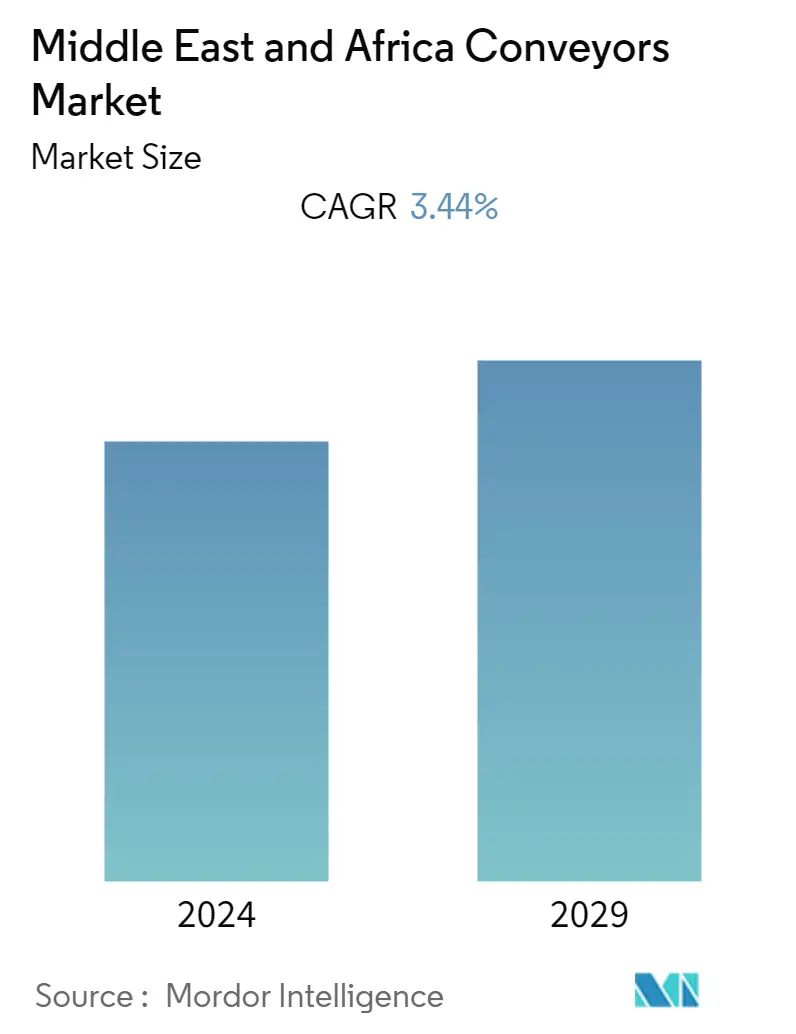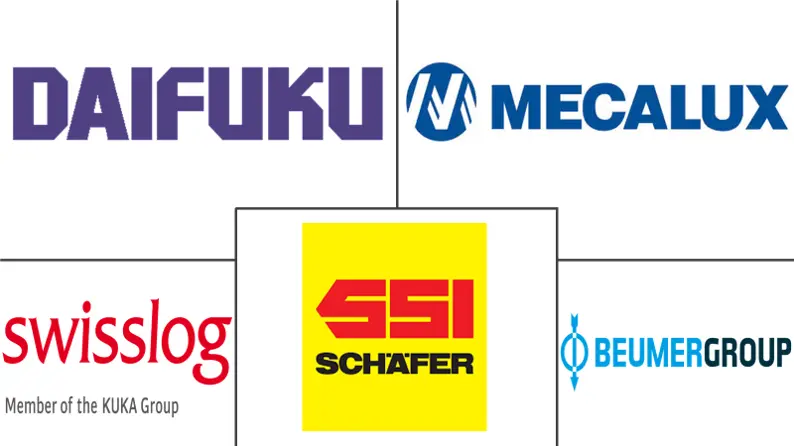Market Size of Middle East and Africa Conveyors Industry

| Study Period | 2019 - 2029 |
| Base Year For Estimation | 2023 |
| Forecast Data Period | 2024 - 2029 |
| Historical Data Period | 2019 - 2022 |
| CAGR | 3.44 % |
| Market Concentration | Medium |
Major Players
*Disclaimer: Major Players sorted in no particular order |
Middle East and Africa Conveyors Market Analysis
The Middle East and Africa Conveyors market is expected to register a CAGR of 3.44% over the forecast period from 2020 to 2025. Multiple countries in the Middle East, such as the United Arab Emirates and Saudi Arabia, have strategically utilized its geographical location to develop as an air transport hub for international flights. The vast infrastructure planned in the pipeline is expected to drive the demand for conveyors in the region. Moreover, various governments in the region, such as Saudi Arabia, are offering substantial administrative and financial support to the manufacturing sector in the region, providing a boost to conveyors' usage. The increasing number of industries and manufacturing units is also expected to drive the demand for automation in the African region.
- Intra-Africa trade is on the rise. African countries signed a trade agreement called the African Continental Free Trade Area Agreement (AfCFTA), which permitted countries to remove tariffs on 90% of goods, progressively liberalizing trade in services, while addressing a host of other non-tariff barriers. These kinds of agreements are expected to increase the need for automation, such as conveyors, to simplify goods' management. Improvements in intra-Africa trade may also ease business in the region, by reducing the time and costs required to move goods and services within countries and across borders. As a whole, they also increase the African continent's appeal as a partner in global trade.
- If a conveyer belt system experiences an extended downtime, the entire production chain often collapses, intensive maintenance and usually repair work is required. Monitoring systems helps the customers to detect damages early and thereby reduce downtimes and save maintenance costs. For instance, in January 2020, South Africa witnessed a power outage caused by a constrained system and damaged conveyor belt at the Medupi power station, caused the first round of load shedding in 2020. Eskom, South African electricity public utility, announced that although the conveyor belt at Medupi had been repaired, it continued load shedding few days due to a loss of additional units that depleted its diesel and pump storage levels, which will need to be restored.
- In March 2020, the Egpyt's government announced its aim during the coming period to maximize the value of the natural oil resources according to a strategy aimed at expanding the petrochemical industry in Egypt. The strategy led to three industrial projects with investments totaling USD 4 billion in the Ethydco Complex and the Mopco Complex for Fertilisers and Alexandria to produce ethylene and its derivatives, a primary material for the plastics industry. Ethydco's investments include a project manufacturing synthetic rubber with an investment of USD 105 million to supply raw materials to 13 sectors, including tyre and conveyor belt manufacturers and construction.
- According to the International Monetary Fund (IMF), the necessary containment measures implemented to slow the COVID-19 spread and lower global demand have significantly impacted economic activity in the Middle East and African region. The region's real GDP is projected to fall by 4.7% in 2020, a 2% drop from the IMF's April 2020 Regional Economic Outlook. Notably, among countries fragile and in conflict situations in the region, the output is now projected to shrink by 13% in 2020. This is expected to significantly influence the region's industrial spending, which could negatively impact the spending on automation systems such as conveyors.
Middle East and Africa Conveyors Industry Segmentation
Conveyor systems are mechanical devices or assemblies that are used to transport various materials with little effort. There are different kinds of conveyor systems, usually consisting of a frame that supports either wheels, rollers, or a belt, upon which the materials move from one place to another. The scope of the study is currently focused exclusively on the Middle East and African region.
| Product Type | |
| Belt | |
| Roller | |
| Pallet | |
| Overhead |
| End-User Industry | |
| Airport | |
| Retail | |
| Automotive | |
| Manufacturing | |
| Food and Beverage | |
| Pharmaceuticals | |
| Mining |
| Country | |
| United Arab Emirates | |
| Saudi Arabia | |
| Israel | |
| South Africa | |
| Rest of Middle East and Africa |
Middle East and Africa Conveyors Market Size Summary
The Middle East and Africa conveyors market is poised for growth, driven by strategic developments in infrastructure and increased industrial activities. Countries like the United Arab Emirates and Saudi Arabia are leveraging their geographical advantages to become air transport hubs, which is expected to boost the demand for conveyor systems. Government support in the form of administrative and financial incentives is further propelling the manufacturing sector, thereby increasing the need for automation solutions such as conveyors. In Africa, the African Continental Free Trade Area Agreement is facilitating intra-regional trade, which is anticipated to enhance the demand for conveyors to streamline goods management. This growing trade activity is expected to reduce logistical costs and time, making the region more attractive for global trade partnerships.
The market landscape is moderately competitive, with international players like Daifuku Co. Ltd, KUKA AG, and Mecalux SA actively participating. These companies are focusing on product innovation and strategic mergers and acquisitions to strengthen their market position. The region's logistics infrastructure, particularly in the UAE, is well-developed, supporting the growth of e-commerce and increasing the demand for advanced conveyor systems. Investments in airport expansions and logistics facilities, such as those in Saudi Arabia and Dubai, are expected to further drive market growth. Despite challenges posed by the COVID-19 pandemic, the market is anticipated to recover and continue its upward trajectory, supported by ongoing infrastructure projects and technological advancements in conveyor systems.
Middle East and Africa Conveyors Market Size - Table of Contents
-
1. MARKET DYNAMICS
-
1.1 Market Overview
-
1.2 Market Drivers
-
1.2.1 Rapid Growth of E-Commerce
-
1.2.2 Rise of Multiple Infrastructure Projects in the Region
-
-
1.3 Market Restraints
-
1.3.1 High Initial Investments
-
-
1.4 Industry Value Chain Analysis
-
1.5 Industry Attractiveness - Porter's Five Forces Analysis
-
1.5.1 Bargaining Power of Suppliers
-
1.5.2 Bargaining Power of Buyers
-
1.5.3 Threat of New Entrants
-
1.5.4 Intensity of Competitive Rivalry
-
1.5.5 Threat of Substitutes
-
-
1.6 Assessment on the impact due to COVID-19
-
-
2. MARKET SEGMENTATION
-
2.1 Product Type
-
2.1.1 Belt
-
2.1.2 Roller
-
2.1.3 Pallet
-
2.1.4 Overhead
-
-
2.2 End-User Industry
-
2.2.1 Airport
-
2.2.2 Retail
-
2.2.3 Automotive
-
2.2.4 Manufacturing
-
2.2.5 Food and Beverage
-
2.2.6 Pharmaceuticals
-
2.2.7 Mining
-
-
2.3 Country
-
2.3.1 United Arab Emirates
-
2.3.2 Saudi Arabia
-
2.3.3 Israel
-
2.3.4 South Africa
-
2.3.5 Rest of Middle East and Africa
-
-
Middle East and Africa Conveyors Market Size FAQs
What is the current Middle East and Africa Conveyors Market size?
The Middle East and Africa Conveyors Market is projected to register a CAGR of 3.44% during the forecast period (2024-2029)
Who are the key players in Middle East and Africa Conveyors Market?
Daifuku Co. Ltd, SSI Schaefer AG, KUKA AG (Swisslog AG), BEUMER Group and Mecalux SA are the major companies operating in the Middle East and Africa Conveyors Market.

